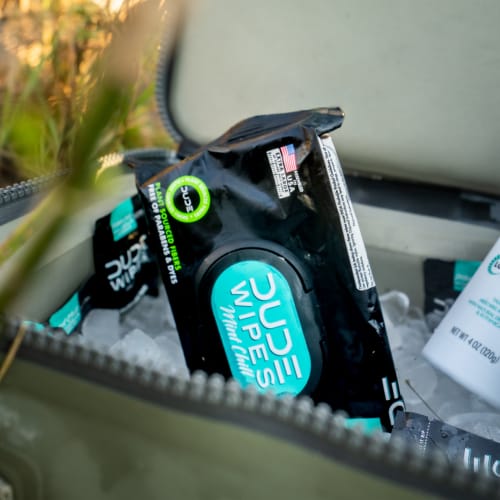If you’re reading this, chances are you’ve been plugged up for a couple of days. Perhaps you’re on the toilet right now, trying to coax that brown snake out of your b-hole, but you’ve had no luck—your morning coffee wasn’t even enough to get things going.
If you go to your local drugstore in search of constipation relief, you’ll find two types of products: stool softeners and laxatives. Both are designed to help you poop, but stool softeners are a specific type of laxative that helps your turds absorb water, making them easier to pass.
So, which type should you take?
In this article, we’ll explain the key differences between stool softeners and laxatives. More importantly, we’ll give you a cheat sheet for when to use each one so you can alleviate your constipation and get back on your game.
Stool Softeners vs. Laxatives: What’s the Difference?
A laxative is any medicine or supplement that helps you have a bowel movement. Stool softeners are a specific type of laxative (an emollient laxative) that moistens the poop inside your colon, making it smoother and easier to push out. There are several other types of laxatives that help you poop, and they all work differently.
Bottom line: All stool softeners are laxatives, but not all laxatives are stool softeners.
Stool softeners are usually gentle and have a mild effect, while some laxatives tend to produce faster and more explosive results in the bathroom.
You can buy most stool softeners and laxatives over-the-counter (OTC) at your local supermarket or drugstore. If your brain feels as stuck as your bowels, check with your healthcare provider to see what they recommend based on your health and how serious your constipation is.
How Do Stool Softeners Work?
Stool softeners (AKA emollient laxatives) increase the water content in your poop, which softens it. They work by drawing water into your intestines. Stool softeners are available OTC as capsules, tablets, soft gels, or oral liquid forms.
Think of it like adding water to really thick pancake batter to smooth it out.
Stool softeners are ideal as a short-term solution to prevent or treat constipation, like after surgery or to counteract the side effects of painkillers that plug you up. Two of the most popular stool softeners are docusate sodium (Colace) and docusate calcium (Surfak).
Potential side effects of stool softeners include stomach cramps, abdominal pain, diarrhea, weakness, hives, and vomiting.
How Do Laxatives Work?
Laxatives are any type of medication or dietary supplement that makes it easier for you to have a bowel movement. Laxatives work in different ways, depending on which type you take. Here are three main kinds:
- Bulk-Forming Laxatives: These add moisture and weight to your poop, making it softer and easier to pass. Two common ingredients are psyllium husk and methylcellulose, which are found in brands like Metamucil and Benefiber.
- Osmotic Laxatives: These pull water from the rest of your body into your intestines to moisten your turds. The most common types are Milk of Magnesia (magnesium hydroxide) Miralax (polyethylene glycol), and lactulose.
- Stimulant Laxatives: These stimulate muscle contractions in your intestines, which forces stool to evacuate out of your butt. Common brands are Dulcolax (bisacodyl), Senokot (senna), and Fleet (bisacodyl).
- Saline Laxatives: These magnesium-based laxatives draw water into your intestines.
- Lubricant Laxatives: These oil-based laxatives coat the lining of your intestines so the poop can make a clean escape.
Laxatives come in several forms, including oral tablets, capsules, liquids, powders, and suppositories that you stick up your butt.
When to Use a Stool Softener
Here’s when a stool softener may be your best bet:
- You want to prevent constipation if you’re taking a certain medication or have a medical condition
- You have hard, dry stools that you can’t pass comfortably
- You get constipated when you travel
- Your doctor recommends it
When To Use a Laxative
Here’s when to consider other types of laxatives:
- You haven’t had a bowel movement in three or more days
- You need fast or immediate constipation relief
- Your healthcare provider prescribes a specific type of laxatives
- Stool softeners haven’t done the trick
Which Type of Laxative Works the Fastest?
If you’re browsing the laxative aisle, you better know how fast each type works so you can time your dose accordingly. The last thing you need on a flight, date, or job interview is a sudden and immediate need to unload a fat dookie.
According to this 2015 study, here’s the approximate time it takes different types of laxatives to spark a bowel movement:
- Osmotic Laxatives: 30 minutes to 6 hours
- Stimulant Laxatives: 6 to 12 hours
- Stool Softeners: 24 to 48 hours
- Fiber-Based Laxatives: 12 to 72 hours
Be Ready for a Blowout with DUDE Wipes
Nothing quite rivals the relief of a fat dump after an extended bout of constipation. You might even feel a few pounds lighter depending on how backed up you were. Don’t ruin that sweet bliss by scorching your anus with dry toilet paper.
While you’re at the store picking up laxatives, make a detour to the TP aisle and grab a pack of DUDE Wipes. Infused with soothing aloe and vitamin E, we turn wiping your ass into a spa treatment for your nether regions.
No matter what you use to cure your constipation, we’ll be on standby for cleanup duty.









Leave a comment
This site is protected by reCAPTCHA and the Google Privacy Policy and Terms of Service apply.